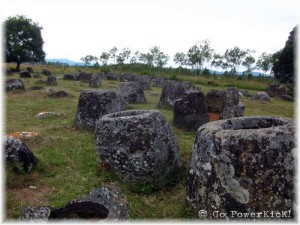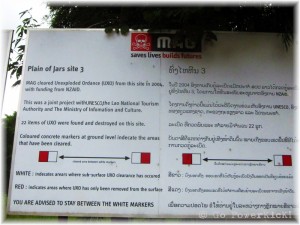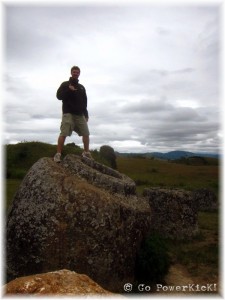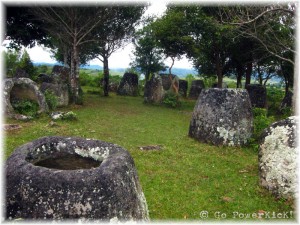 Scattered about the coordinates 19.46°N 103.18°E is what some archaeologists maintain to be one of Southeast Asia’s most important archaeological sites. Lying just outside of Phonsovan, in eastern Laos, along the foothills of the Xieng Khouang plateau are thousands of megalithic jars. First discovered by the French in the 1930’s, the Plain of Jars is estimated to date back 2,000 years; although no one is certain of their exact date. Unlike the Angkor temples in Cambodia and most other ancient Asian sites, whose secrets have been unraveled, historians still cannot pinpoint where the jars came from, how old they are and their significance.
Scattered about the coordinates 19.46°N 103.18°E is what some archaeologists maintain to be one of Southeast Asia’s most important archaeological sites. Lying just outside of Phonsovan, in eastern Laos, along the foothills of the Xieng Khouang plateau are thousands of megalithic jars. First discovered by the French in the 1930’s, the Plain of Jars is estimated to date back 2,000 years; although no one is certain of their exact date. Unlike the Angkor temples in Cambodia and most other ancient Asian sites, whose secrets have been unraveled, historians still cannot pinpoint where the jars came from, how old they are and their significance.
Arranged in clusters along the foothills; the jar formations range from a single jar to several  hundred. Over 100 jar sites have been located through the area. However, sites 1, 2, 3 and 16 are the most accessible to visitors. The inaccessibility of other sites is due to the presence of Unexploded Ordinances (UXO’s). These are remnants of bombing campaigns during the secret war carried out in Laos during the Vietnam War. The main sites have been cleared of UXO’s and visitors are able to enter and explore. I still advise to stay on the paths and to not venture off.
hundred. Over 100 jar sites have been located through the area. However, sites 1, 2, 3 and 16 are the most accessible to visitors. The inaccessibility of other sites is due to the presence of Unexploded Ordinances (UXO’s). These are remnants of bombing campaigns during the secret war carried out in Laos during the Vietnam War. The main sites have been cleared of UXO’s and visitors are able to enter and explore. I still advise to stay on the paths and to not venture off.
A quick history lesson, not usually given, regarding the Vietnam war will show the North  Vietnamese Army invading and occupying the eastern boarder of Laos. Their plans were to move supplies down the Ho Chi Minh trail to forces in the South. The Laos occupation was against the consent of the Royal Lao Government and their people. The United States of America was asked by the Lao government to aid in the removal of the North Vietnamese Army. From 1960 – 1974 the CIA waged a secret war in Laos (alongside the Lao army) against the Vietnamese. Part of the strategy to eradicate the North Vietnamese Army from Laos was a massive bombing campaign.
Vietnamese Army invading and occupying the eastern boarder of Laos. Their plans were to move supplies down the Ho Chi Minh trail to forces in the South. The Laos occupation was against the consent of the Royal Lao Government and their people. The United States of America was asked by the Lao government to aid in the removal of the North Vietnamese Army. From 1960 – 1974 the CIA waged a secret war in Laos (alongside the Lao army) against the Vietnamese. Part of the strategy to eradicate the North Vietnamese Army from Laos was a massive bombing campaign.  The bombing lasted roughly 13 years with the cumulative total of bombs dropped in Laos exceeding that of all bombs dropped by all allied forces in World War II. In total 1.3 million tons of bombs were dropped throughout Laos. The effects of which are still being felt generations later.
The bombing lasted roughly 13 years with the cumulative total of bombs dropped in Laos exceeding that of all bombs dropped by all allied forces in World War II. In total 1.3 million tons of bombs were dropped throughout Laos. The effects of which are still being felt generations later.
At Site 1 evidence of the war can be seen in the form of broken or displaced jars, trench systems and even bomb craters. Site 1 is the largest current jar site with a couple hundred jars. Ranging from 1 to 3 meters in height and weighing from a few hundred pounds up to several tons, the jars themselves are really quite impressive. Analysis done shows five rock types were used to make up the jars: sandstone, granite,  conglomerate, limestone and breccia.
conglomerate, limestone and breccia.
With no clear consensus as to their origins, theories have emerged trying to explain the Jars. Local Hmong legends tell stories and claim there was once a race of giants who inhabited the area. The legend tells of an ancient king, Khun Cheung, who fought a long and eventually victorious battle against his enemy. He allegedly created the jars to brew and store huge amounts of lao lao rice wine to celebrate his victory.
Others have been lead to suggest the jars are enormous urns of an ancient burial site as  evidence of bone fragments, beads, iron and bronze objects have been found around some of the jars. There is also speculation the plain was at the connection point of old caravan routes, in particular with the salt trade, coming from India. Similar trade thoughts associate the jars to long-distance overland routes connecting the Mekong basin and the Gulf of Tonkin in Vietnam.
evidence of bone fragments, beads, iron and bronze objects have been found around some of the jars. There is also speculation the plain was at the connection point of old caravan routes, in particular with the salt trade, coming from India. Similar trade thoughts associate the jars to long-distance overland routes connecting the Mekong basin and the Gulf of Tonkin in Vietnam.
As more is learned about the Jars and the sites move toward UNESCO status; hopefully one day the true meaning and use of the Jars will come to light. However, for now it’s fun to let your mind run wild with the realm of possible explanations. I’m going to stick with the Hmong legend. I like the thought of Giants living among the plains and using it to store their lao lao. Sounds like these giant brew masters were ahead of their time!
Comments
More Good Reads!

The Best Mai Tai In The World
May 23, 2014
Helicopter Over Oahu
May 10, 2014
Bike The Golden Gate Bridge
April 29, 2014
Hua Hin Hills Vineyard
April 19, 2014
Songkran in Nan
April 10, 2014
How To Spend A Day In Ayutthaya
March 07, 2014
Khlong Lat Mayom Floating Market
February 19, 2014
Khao Ngon Nak: Dragon Crest Mountain
January 28, 2014
Koh Lipe: An Island Paradise
January 14, 2014
























